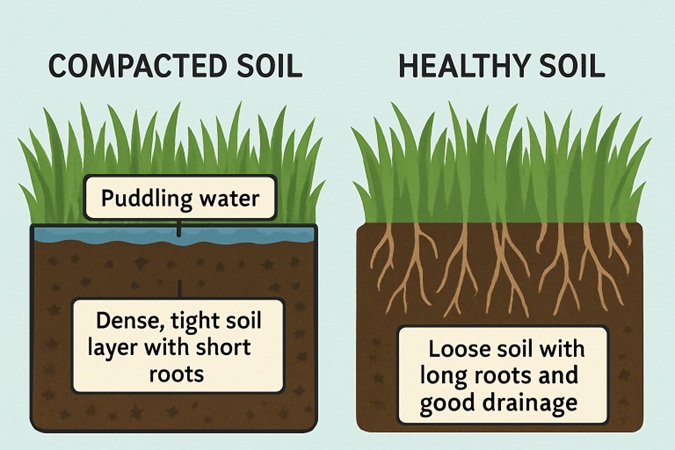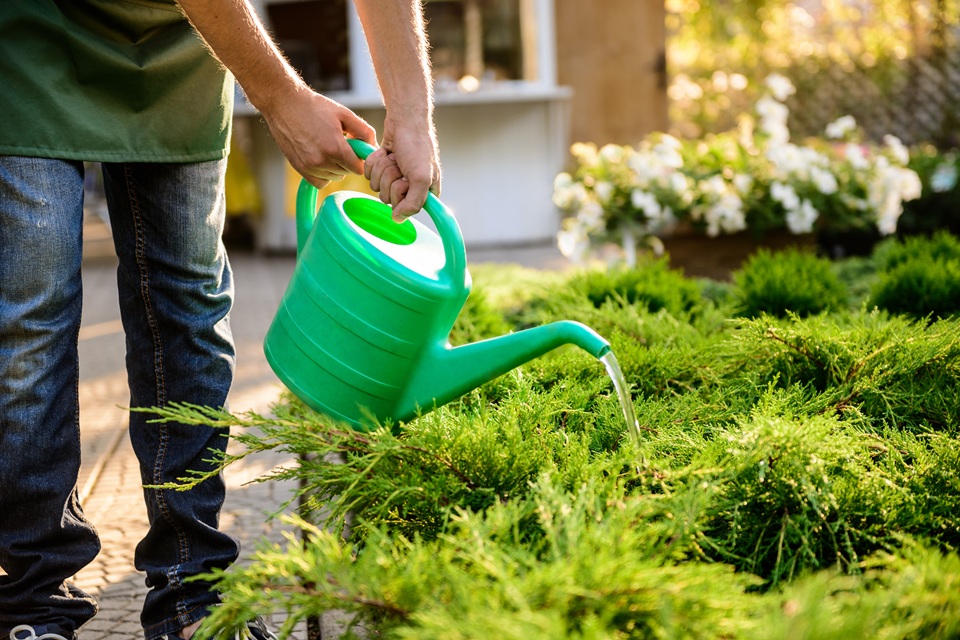Key Takeaways:
- Soil compaction restricts root growth, limits drainage, and leads to unhealthy lawns.
- Remediation techniques, such as aeration and the addition of organic matter, restore soil structure.
- Preventive practices help avoid long-term lawn and drainage problems.
Introduction
Many lawns struggle with uneven growth, persistent puddles, or thinning grass, but the underlying problem often stems from poor soil structure. Soil compaction, a frequently overlooked yet significant issue, can undermine even the most effective lawn care efforts. Addressing compaction is as crucial as tasks like yard leveling and grading in Rock Hill, ensuring your lawn receives the necessary nutrients, water, and air to thrive.
When soil becomes compacted, its pore spaces collapse, making it difficult for water to drain and for roots to expand and grow. This disruption affects lawn health from the ground up—literally weakening grass, increasing the risk of yard flooding, and making routine maintenance less effective.
Lawns in high-traffic or newly constructed areas are particularly susceptible to compaction. Children playing, pets running, and heavy machinery can quickly compress the soil, driving out air and impacting drainage.
Knowing the causes, effects, and solutions for soil compaction allows property owners to proactively restore and protect their outdoor spaces for years to come.

What Is Soil Compaction?
Soil compaction is the process in which soil particles are pressed tightly together, reducing the amount of pore space. This increase in soil density creates a tough barrier that hinders water infiltration, root penetration, and the exchange of gases such as oxygen and carbon dioxide. Compacted soil can feel as hard as concrete, making it unsuitable for healthy turf growth and robust landscaping. Proper slab preparation often requires addressing soil compaction first to ensure a stable, level base for concrete or paving projects.
Causes Of Soil Compaction
Foot Traffic
Everyday activities, including walking, running, and playing, concentrate pressure on the soil surface. Over time, this repeated compression eliminates natural pore spaces, especially in clay-heavy soils.
Heavy Machinery
Construction and landscaping machinery, ranging from excavators to lawn mowers, can quickly compact moist soil, especially after rainfall. New developments or landscaping work are frequent culprits, sometimes flattening soil several inches deep.
Natural Causes
Even if an area sees little foot traffic, heavy, consistent rainfall can also trigger compaction. Clay soils are particularly at risk, as they readily seal up and lose their loose, friable texture after storms.
Effects On Lawn Health
- Poor Root Development: Grass roots need air and space to branch out. Compacted soils suffocate roots, limiting their depth and resilience, often resulting in yellowing or patchy grass.
- Reduced Water Infiltration: When water can’t penetrate, it pools on the surface or runs off entirely, starving deeper roots and wasting both irrigation and rainwater.
- Increased Vulnerability to Pests and Disease: Weakened turf is more susceptible to insect infestations, fungal diseases, and weed encroachment.
Compacted soil can have devastating effects during both droughts and floods, making robust lawn management strategies essential.
Impact On Drainage
Poor drainage is one of the earliest and most visible warnings of soil compaction. Without open pore spaces, water remains on the surface, creating muddy patches and increasing erosion concerns. Stagnant water also elevates the risk of fungal diseases, which further threaten lawn integrity. Effective drainage is not merely a cosmetic concern—it’s fundamental to maintaining a lush, healthy lawn and protecting property value.
Identifying Soil Compaction
Vigilance is key. Homeowners should look for telltale signs, including water that lingers long after a rainstorm, bare or thinning patches where grass refuses to grow, and resistance when inserting tools like garden forks or soil probes into the ground. If digging a hole feels more like chiseling rock than scooping dirt, compaction is likely the root cause.
Remediation Techniques
- Aeration: The most effective technique is mechanical aeration, which involves removing small plugs of soil to allow roots to breathe and moisture to penetrate.
- Organic Matter Addition: Mixing compost or organic amendments into the soil helps improve its structure, boosting resilience against future compaction and increasing beneficial microbial activity.
- Traffic Management: Minimize movement in especially vulnerable spots, and avoid working on the lawn when the soil is wet, as it compacts more easily under pressure.
Preventive Measures
- Create dedicated walkways for high-traffic areas to spread out the impact across the lawn.
- Build routine aeration into annual maintenance schedules, focusing on frequently used or shady sections.
- Rely on smart watering and mowing practices to support deeper root systems, which help keep soil loose and biologically active.
Forming healthy habits—such as mulching grass clippings and applying organic matter—encourages better soil structure over time and makes future maintenance easier.
Final Thoughts
Carefully monitoring, identifying, and addressing soil compaction is crucial for the long-term health and vitality of any lawn. Proactive strategies—such as aeration, composting, and thoughtful site management—restore the soil’s natural capacity to drain efficiently and support robust plant growth. By prioritizing soil health alongside regular yard grading and hardscape preparation, property owners set the stage for outdoor success, resilient landscapes, and neighborhoods filled with thriving green spaces.






Leave a Reply